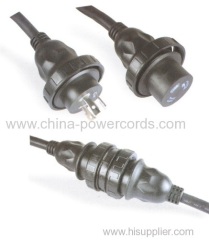
3outlet US power extension cord
| Min. Order: | 2000 Piece/Pieces |
|---|---|
| Trade Term: | FOB |
| Payment Terms: | L/C, T/T |
| Supply Ability: | 200000PCS per month |
| Place of Origin: | Zhejiang |
Company Profile
| Location: | Ningbo, Zhejiang, China (Mainland) |
|---|---|
| Business Type: | Manufacturer, Agent |
| Main Products: | Power Surge Protector, Master Slave Extension Lead, Indoor Extension Cord, USB Surge Suppressor, UL Outdoor Power Stake |
Product Detail
| Model No.: | A70013 |
|---|---|
| Means of Transport: | Ocean, Air |
| Rated Voltage: | 125V |
| Rated Current: | 15A |
| Switch: | 2-in-1 |
| Color: | grey or white |
| Plastic: | ABS fire assistant |
| authentication: | UL approved |
| Packing: | Sleeve or box |
| Production Capacity: | 200000PCS per month |
| Packing: | Sleeve card / double blister /color box & carton |
| Delivery Date: | 30 days |
Product Description
product name : 3outlet US power extension cord
Ac 125V 13A 1625W 60HZ
Ac 125V 13A 1625W 60HZ
2+1 outlet extension cord
ABS Resistance burning(94v-0) housing
16awg SJT-3 heavy duty power cord
ETL & Prop65 approved


An extension cord, power extender, or extension lead is a length of flexible electrical power cable (flex) with a plug on one end and one or more sockets on the other end (usually of the same type as the plug). The term usually refers to mains (household AC) extensions but is also used to refer to extensions for other types of cabling.
To avoid the need to roll-up any excess length, and to avoid the need for the user to cut the cord to size, extension cords are sold in prefabricated lengths 1 to 150 feet (30 cm to 45 m). The longer the cord the larger the diameter of the conductors (wire gauges are larger for smaller diameter wire) should be to minimise voltage drop. Every extra foot of cord increases the electrical resistance, which decreases the power the cord can deliver to connected devices. Because of this, it is best to use a cord as long as is needed
In the United States where the domestic voltage is 120 V, the National Electrical Code (NEC) prohibits the use of extension cords in a 20 A circuit unless they are of 16 AWG or larger (for example, 14 AWG or 12 AWG). As with other flexible cords, the NEC also prohibits their use where attached to building surfaces, or concealed inside walls, floors, or ceilings, above suspended ceilings, or where run through holes or other openings (windows, doors) in structures (with limited exceptions). Cords run across the floor should be covered with a suitable device to protect them from physical damage.


.jpg)
.jpg)



